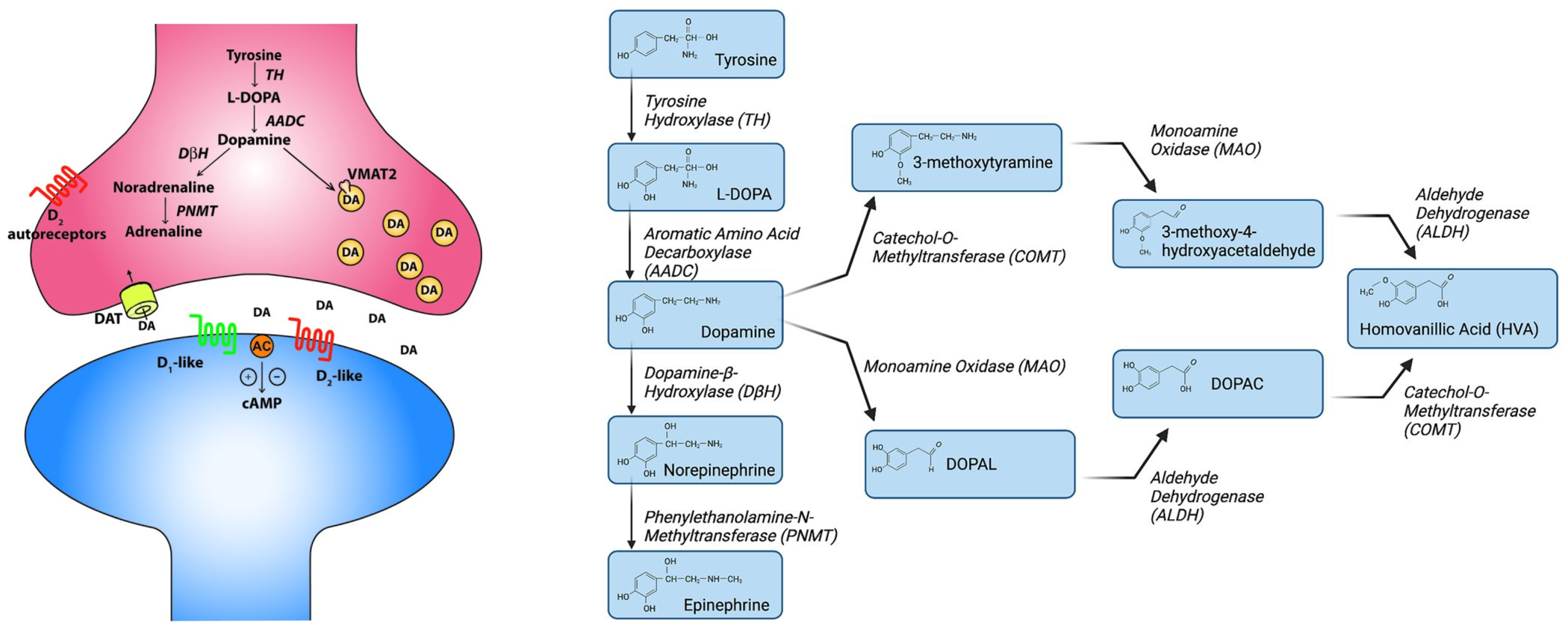Neurotransmitters (Catecholamine)
The term “catecholamine” typically describes organic compounds that contain a catechol nucleus, characterized by a benzene ring with two adjacent hydroxyl groups, along with an amine group.
Here’s the table that includes specific parts of the central nervous system (CNS) involved in the release of catecholamines:
| Catecholamine | Releasing Neurons | Receptors | Nervous System | Specific Parts of CNS |
|---|---|---|---|---|
| Dopamine | Dopaminergic neurons | D1, D2, D3, D4, D5 (dopamine receptors) | Central Nervous System (CNS) | Substantia nigra, ventral tegmental area, striatum, prefrontal cortex |
| Norepinephrine | Noradrenergic neurons | Alpha (α1, α2) and Beta (β1, β2, β3) adrenergic receptors | Sympathetic Nervous System and CNS | Locus coeruleus, hypothalamus, spinal cord |
| Epinephrine | Adrenergic neurons | Alpha (α1, α2) and Beta (β1, β2, β3) adrenergic receptors | Sympathetic Nervous System | Adrenal medulla, some brain regions (e.g., hypothalamus) |
Here’s a table summarizing the key genes or proteins involved in the synthesis and transport of catecholamine neurotransmitters:
| Catecholamine | Gene/Protein | Function |
|---|---|---|
| Dopamine | TH (Tyrosine Hydroxylase) | Converts tyrosine to L-DOPA, the first step in dopamine synthesis. |
| DDC (DOPA Decarboxylase) | Converts L-DOPA to dopamine. | |
| VMAT2 (Vesicular Monoamine Transporter 2) | Transports dopamine into synaptic vesicles for storage and release. | |
| DAT (Dopamine Transporter) | Reuptakes dopamine from the synaptic cleft back into neurons. | |
| Norepinephrine | TH (Tyrosine Hydroxylase) | Converts tyrosine to L-DOPA (also involved in norepinephrine synthesis). |
| DDC (DOPA Decarboxylase) | Converts L-DOPA to dopamine (as a precursor). | |
| DBH (Dopamine β-Hydroxylase) | Converts dopamine to norepinephrine. | |
| VMAT2 (Vesicular Monoamine Transporter 2) | Transports norepinephrine into synaptic vesicles. | |
| NET (Norepinephrine Transporter) | Reuptakes norepinephrine from the synaptic cleft back into neurons. | |
| Epinephrine | TH (Tyrosine Hydroxylase) | Converts tyrosine to L-DOPA (as with dopamine and norepinephrine). |
| DDC (DOPA Decarboxylase) | Converts L-DOPA to dopamine (as a precursor). | |
| DBH (Dopamine β-Hydroxylase) | Converts dopamine to norepinephrine (also involved). | |
| PNMT (Phenylethanolamine N-Methyltransferase) | Converts norepinephrine to epinephrine. | |
| VMAT2 (Vesicular Monoamine Transporter 2) | Transports epinephrine into synaptic vesicles. | |
| NET (Norepinephrine Transporter) | Reuptakes norepinephrine and indirectly affects epinephrine levels. |
Note: The DDC gene provides instructions for making the aromatic l-amino acid decarboxylase (AADC) enzyme.
Dopamine synthesis and metabolism and, uptake of levodopa-derived dopamine.

- Dopamine synthesis begins with the hydroxylation of tyrosine by TH to produce L-DOPA, which is then converted to dopamine by AADC.
- DBH hydroxylates dopamine to form norepinephrine, which is further converted to epinephrine by PNMT.
- Dopamine is mainly broken down by two enzymes, Catechol-O-Methyltransferase(COMT) and Monoamine Oxidase(MAO).
- COMT converts dopamine to 3-methoxytyramine, which MAO then converts to 3-methoxy-4-hydroxyacetaldehyde.
- Alternatively, MAO breaks dopamine down into 3,4-dihydroxyphenylacetaldehyde, which ALDH converts to DOPAC.
Finally, ALDH and COMT process 3-methoxy-4-hydroxyacetaldehyde and DOPAC into Homovanillic Acid (HVA).
- VMAT2 (Vesicular Monoamine Transporter 2; SLC18A2): Transports dopamine, norepinephrine, and epinephrine into synaptic vesicles for storage and release.
- DAT (Dopamine Transporter; SLC6A3): Reuptakes dopamine from the synaptic cleft.
- NET (Norepinephrine Transporter; SLC6A2): Reuptakes norepinephrine from the synaptic cleft.
- OCT-3 (Organic Cation Transporter 3; SLC22A3): SLC22A3 is known to transport compounds such as dopamine, serotonin, norepinephrine, and various medications including metformin and certain antidepressants.
- MAO-A primarily degrades serotonin, norepinephrine, and dopamine, while MAO-B specifically metabolizes phenylethylamine and dopamine.
